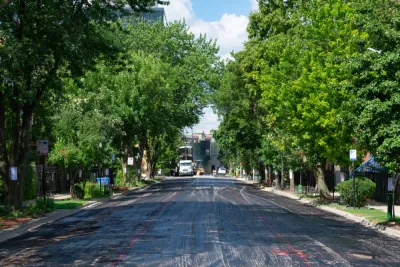A new mapping tool visualizes the unequal distribution of urban trees in U.S. cities.

An analysis from American Forests, a conservation nonprofit, has found glaring discrepancies in the availability of trees in low-income neighborhoods and communities of color, writes Linda Poon for Bloomberg CityLab. According to the study, "[n]eighborhoods with a majority of people of color have, on average, 33% less tree canopy than majority-white communities," while "[t]he poorest neighborhoods, where 90% of residents live in poverty, have 41% less coverage than the wealthiest ones."
American Forests' new project, the Tree Equity Score map, highlights the difference in tree canopy across neighborhoods, indicating that this tracks closely with social and economic characteristics. "As Jad Daley, president and CEO of American Forests, told CityLab last August, any map of tree cover in a U.S. city likely reflects its racial and socioeconomic divide." As such, "the map is meant to be a tool for advocates and local officials. The score reflects how many trees are needed in each tract based on factors like the region’s climate and population density, as well as six equity measures: income level, employment rate, race, age distribution, health outcomes and the severity of the urban heat island effect."
"Nationally, some 522 million new trees are needed for every city to reach a score of 100, according to the analysis. That could lead to the creation of more than 3.8 million jobs, curb air pollution by 56,613 tons of particulates each year, and remove 9.3 million tons of carbon from the atmosphere — equivalent to 92 million cars, the analysis estimates. It could also generate roughly $5 billion in annual ecosystem service benefits, like air quality improvement and stormwater drainage."
The tool's creators hope that the map "could be particularly helpful to cities with fewer resources and smaller budgets to conduct their own tree canopy survey."
FULL STORY: The U.S. Neighborhoods With the Greatest Tree Inequity, Mapped

Analysis: Cybertruck Fatality Rate Far Exceeds That of Ford Pinto
The Tesla Cybertruck was recalled seven times last year.

National Parks Layoffs Will Cause Communities to Lose Billions
Thousands of essential park workers were laid off this week, just before the busy spring break season.

Retro-silient?: America’s First “Eco-burb,” The Woodlands Turns 50
A master-planned community north of Houston offers lessons on green infrastructure and resilient design, but falls short of its founder’s lofty affordability and walkability goals.

Test News Post 1
This is a summary

Analysis: Cybertruck Fatality Rate Far Exceeds That of Ford Pinto
The Tesla Cybertruck was recalled seven times last year.

Test News Headline 46
Test for the image on the front page.
Urban Design for Planners 1: Software Tools
This six-course series explores essential urban design concepts using open source software and equips planners with the tools they need to participate fully in the urban design process.
Planning for Universal Design
Learn the tools for implementing Universal Design in planning regulations.
EMC Planning Group, Inc.
Planetizen
Planetizen
Mpact (formerly Rail~Volution)
Great Falls Development Authority, Inc.
HUDs Office of Policy Development and Research
NYU Wagner Graduate School of Public Service

























